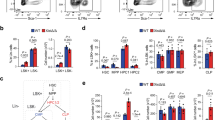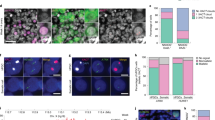Abstract
Mammals compensate for different doses of X–chromosome–linked genes in male (XY) and female (XX) somatic cells by terminally inactivating all but one X chromosome in each cell. A transiently inactive X chromosome is also found in germ cells, specifically in premeiotic oogenic cells and in meiotic and postmeiotic spermatogenic cells. Here we show that the Xist gene, which is a expressed predominantly from the inactive X–chromosome in female somatic cells, is also expressed in germ cells of both sexes, but only at those stages when an inactive X chromosome is present. This suggests support for the putative role of Xist as a regulator of X–chromosome inactivation and suggest a common mechanism for the initiation and/or maintenance of X–chromosome inactivation in all cell types.
This is a preview of subscription content, access via your institution
Access options
Subscribe to this journal
Receive 12 print issues and online access
$209.00 per year
only $17.42 per issue
Buy this article
- Purchase on Springer Link
- Instant access to full article PDF
Prices may be subject to local taxes which are calculated during checkout
Similar content being viewed by others
References
Kratzer, P.G. & Gartler, S.M. HGPRT activity changes in preimplantation mouse embryos. Nature 274, 503–504 (1978).
Lyon, M.F. Gene action in the X-chromosome of the mouse (Mus musculus L.). Nature 190, 372–373 (1961).
Gartler, S.M. & Riggs, A.D. Mammalian X-chromosome inactivation. A. Rev. Genet. 17, 155–190 (1983).
Kratzer, P.G. & Chapman, V.M. X-chromosome reactivation in oocytes of Mus caroli. Proc. natn. Acad. Sci. U.S.A. 78, 3093–3097 (1981).
Gartler, S.M., Liskay, R.M., Campbell, B.K., Sparkes, R. & Gant, N. Evidence for two functional X chromosomes in human ooctyes. Cell Diff. 1, 215–218 (1972).
McMahon, A., Fosten, M. & Monk, M. Random X-chromosome inactivation in female primordial germ cells in the mouse. J. Embryol. exp. Morphol. 64, 251–258 (1981).
McCarrey, J.R., Dilworth, D.D. & Sharp, R.M. Semi-quantitative analysis of X-linked gene expression during spermatogenesis in the mouse based on ethidium-bromide staining of RT-PCR products. Gen. Anal. Tech. Appl. (in the press).
Singer-Sam, J., Robinson, M.O., Bellve, A.R., Simon, M.I. & Riggs, A.D. Measurement by quantitative PCR of changes in Hprt, Pgk-1, Aprt, Mtase, and Zfy gene transcripts during mouse spermatogenesis. Nucl. Acids Res. 18, 1255–1259 (1990).
McCarrey, J.R. et al. Differential transcription of Pgk genes during spermatogenesis in the mouse. Devl. Biol. 153 (In the press).
Grant, S.G. & Chapman, V.M. Mechanisms of X-chromosome regulation. A. Rev. Genet. 22, 199–233 (1988).
Brown, S.D.M. XIST and the mapping of the X chromosome inactivation center. BioEssays 13, 607–612 (1991).
Brown, C.J. et al. Localization of the X inactivation center on the human X chromosome in Xq13. Nature 349, 82–84 (1991).
Brown, C.J. et al. A gene from the region of the human X inactivation center is expressed exclusively from the inactive X chromosome. Nature 349, 38–44 (1991).
Borsani, G. et al. Characterization of a murine gene expressed from the inactive X chromosome. Nature 351, 325–329 (1991).
Brockdorff, N. et al. Conservation of position and exclusive expression of mouse Xist from the inactive X chromosome. Nature 351, 329–332 (1991).
Kafri, T. et al. Developmental pattern of gene-specific DNA methylation in the mouse embryo and germ line. Genes Dev. 6, 705–714 (1992).
Romrell, L.J., Bellve, A.R. & Fawcett, D.W. Separation of mouse spermatogenic cells by sedimentation velocity. A morphological characterization. Devl. Biol. 49, 119–131 (1976).
Bellve, A.R. et al. Spermatogenic cells of the prepuberal mouse. Isolation and morphological characterization. J. Cell Biol. 74, 68–85 (1977).
Hahnel, A.C. & Eddy, E.M. Cell surface markers of mouse primordial germ cells defined by two monoclonal antibodies. Gam. Res. 15, 25–34 (1986).
McCarrey, J.R., Hsu, K.C., Eddy, E.M., Klevecz, R.R. & Bolen, J.L. Isolation of viable mouse primordial germ cells by antibody-directed flow sorting. J. exp. Zool. 242, 107–111 (1987).
Monesi, V. Ribonucleic acid and protein synthesis during differentiation of male germ cells in the mouse. Archs Anat. microsc. Morph. Exp. 56, 61–74 (1967).
Handel, M.A., Hunt, P.A., Kot, M.C., Park, C. & Shannon, M. Role of sex chromosomes in the control of male germ-cell differentiation. Ann. N.Y. Acad. Sci. 637, 64–73 (1991).
Singer-Sam, J., Goldstein, L., Dai, A., Gartler, S.M. & Riggs, A.D. A potentially critical Hpa II site of the X chromosome-linked PGK1 gene is unmethylated prior to the onset of meiosis of human oogenic cells. Proc. natn. Acad. Sci. U.S.A. 89, 1413–1417 (1992).
Venolia, L., Cooper, D.W., O'Brien, D.A., Millette, C.F. & Gartler, S.M. Transformation of the Hprt gene with DNA from spermatogenic cells. Implications for the evolution of X-chromosome inactivation. Chromosoma 90, 185–189 (1984).
Ballabio, A. & Willard, H.F. Mammalian X-chromosome inactivation and the XIST gene. Curr. Opin. Genet. Dev. 2, 439–447 (1992).
Chirgwin, J.M., Przybyla, A.E., MacDonald, R.J. & Rutter, W.J. Isolation of biologically active ribonucleic acid from sources enriched in ribonuclease. Biochemistry 18, 5294–5299 (1979).
Hahnel, A.C. et al. Two alkaline phosphatase genes are expressed during early development in the mouse embryo. Development 110, 555–564 (1990).
Dilworth, D.D. & McCarrey, J.R. Single-step elimination of contaminating DNA prior to reverse transcriptase PCR. PCR Meth. Applic. 1, 279–282 (1992).
Tokunaga, K., Taniguchi, H., Yoda, K., Shimizu, M. & Sakiyama, S. Nucleotide sequence of a full-length cDNA for mouse cytoskeletal β-actin mRNA. Nucl. Acids Res. 14, 2829 (1986).
Murakawa, G.J. et al. Direct detection of HIV-1 RNA from AIDS and ARC patient samples. DNA 7, 287–295 (1988).
Author information
Authors and Affiliations
Rights and permissions
About this article
Cite this article
McCarrey, J., Dilworth, D. Expression of Xist in mouse germ cells correlates with X–chromosome inactivation. Nat Genet 2, 200–203 (1992). https://doi.org/10.1038/ng1192-200
Received:
Accepted:
Issue Date:
DOI: https://doi.org/10.1038/ng1192-200
This article is cited by
-
The adult human testis transcriptional cell atlas
Cell Research (2018)
-
Evolutionary origin of chromatin remodeling for dosage compensation: Lessons from epigenetic modifications of X chromosomes in germ cells of Drosophila, C.elegans and Mammals
The Nucleus (2012)
-
The Coded Functions of Noncoding RNAs for Gene Regulation
Molecules and Cells (2011)
-
X-chromosome inactivation: a hypothesis linking ontogeny and phylogeny
Nature Reviews Genetics (2005)
-
Mapping of a haploid transcribed and translated sperm-specific gene to the mouse X Chromosome
Mammalian Genome (1997)



